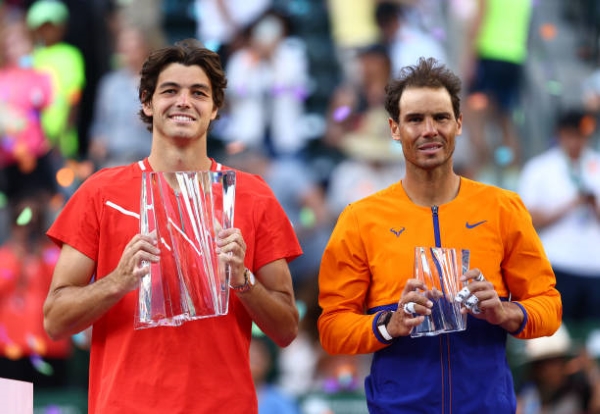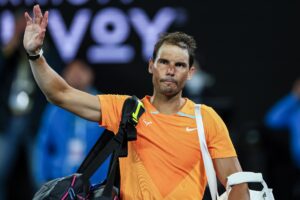Perhaps it is the rarefied air that Rafael Nadal is now breathing as statistically the most successful male player ever that caused him such problems in the Indian Wells Final, to the extent that he ultimately succumbed, relatively meekly, to Taylor Fritz. But whatever the cause of those problems, they are a reminder of Nadal’s great vulnerability as an athlete, which must cast at least some doubt on his hopes of adding to his historic total of 21 Majors.
Unlike Those of Djokovic and Federer, Nadal’s Annus Mirabilis Ended Early and Abruptly
Unlike those of his great rivals, Novak Djokovic and Roger Federer, Nadal’s own annus mirabilis, which 2022 had looked like being, ended early and abruptly. In 2011, Djokovic had begun his decade of domination of men’s tennis by winning every game he played (including the Australian Open final) until he finally lost to Federer in the semifinal of the French Open, almost exactly halfway through the calendar year. Similarly, in 2017 Federer began his own late, great phase as a tennis artist (a phase that has surely come to an end now after two years of injury woes) by winning the Australian Open, skipping the French Open and then winning Wimbledon for a record eighth time.
Until last night’s final in the California desert, it had appeared possible that Nadal would at least match if not better Federer and Djokovic’s best ever years by thoroughly dominating the 2022 season. He had gone a remarkable 20 games unbeaten, winning three titles in the process (a warm-up event before the Australian Open, the Australian Open itself and Acapulco), and was beginning to look virtually unbeatable, especially after his incredible victories at Indian Wells over Nick Kyrgios and Carlos Alcaraz. That was until events, or more specifically injuries or illness, dictated otherwise.
Nadal Has Always Been The Most Physically Fragile Of The Big Three
Given Nadal’s extremely long list of previous injury problems, it was perhaps inevitable that he would end up falling short of dominating an entire calendar year, or even the first half of it. After all, he had missed almost the entire second half of the 2021 season after losing the epic French Open semifinal against Novak Djokovic, which was far from the first time that he has ended up missing a large chunk of the ATP Tour, especially after the European clay court season that he has invariably dominated.
That was partly why his most devoted fans (the Rafaelites) had hoped that he could follow Federer’s example in 2017 and return to the tour after long-term injury to dominate it once again. That had certainly been the case with Federer, who missed the second half of the 2016 season to recover from injury and remodel his backhand such that he could take on, and even beat, Nadal in a Major final, something that he had not achieved for nearly a decade before beating him in Melbourne at the start of 2017.
However, Federer and Nadal have always been almost polar opposites in their injury records, as in so many other aspects of their game. Whereas Federer seemed to avoid serious injury for almost the entirety of his career, at least until late 2016, Nadal has always been beset by a seemingly unending litany of injuries and illnesses that have prevented him from ever completely bestriding the men’s tour in the way that the two other members of The Big Three have done, at least for a period of time. And that is evident again now.
What Next For Nadal?
Nadal had already withdrawn from Miami, the second half of the spring “Sunshine Double” in the US (after Indian Wells), before he experienced such unprecedented breathing difficulties in the final against Fritz. This in itself was a clear acknowledgement of his ongoing physical frailty, such that he could not play two successive hardcourt tournaments in the US, however prestigious, ahead of the European clay court season In this respect, he was again copying Federer, who did not play any clay court events in either 2017 and 2018, in a self-professed attempt to try to avoid the physical problems that clay invariably caused him.
However, whereas Nadal had always planned to just play one of Indian Wells or Miami, it must have been very upsetting, if not downright worrying, for him to have developed at this late stage of his career a completely new injury or illness of the kind that prevented him from showing anything like the form that had carried him into the final. That form had included the remarkable semi-final form that had eventually allowed him to defeat “The New Nadal” (aka Carlos Alcaraz) in a truly epic three-set match, which included a 20-minute Nadal service game at the end of the second set, before Alcaraz finally broke him and then served out for that set.
It is possible, of course, that Nadal’s astonishing efforts against both Kyrios and Alcaraz eventually took their toll on him, contributing to a general physical weariness that may have been exacerbated by the uniquely hot and dusty conditions of Indian Wells (aka tennis in the desert). Nevertheless, it is likely that he will now spend the next few weeks before the start of the clay court season in Monte Carlo undergoing strenuous medical tests, to make sure that there is no repeat of the breathing problems that almost immediately left him 4-0 down in the first set against Fritz, who himself had been doubtful to play the Indian Wells final after badly injuring his ankle against Andrei Rublev in his semifinal. By the time the problems eased at least a little, the first set was gone for Nadal and he could never fully recover.
The Long-Term Future For Nadal – And Men’s Tennis In General
At this stage, prior to any update from Nadal about his medical condition, it is impossible to know what, if any, long-term effects will result from his ultimately unsuccessful Indian Wells 2022 campaign. In the short term, it has obviously brought to a shuddering halt the spectacular run that he had sustained since the very start of the year and that had looked, especially after his titanic victory over Alcaraz, capable of being sustained at least to the end of Indian Wells before, ironically enough, he would take a well-earned breather before the clay-court season began.
Now, that plan has had to be adapted, if not shelved. For all of his truly historic domination of most of the events on the men’s clay court swing around Europe, Nadal will be wary of competing at Monte Carlo, Madrid and even Paris if there is any possibility that his breathing problems might return, especially in the hot and dusty conditions of a premier clay court event.
These new medical problems also suggest that Nadal is extraordinarily unlikely to be as dominant in the rest of 2021 as he has been so far. For one thing, the now-unique five-set demands of a Major are likely to place even greater stress on any underlying physical weakness. For another, he will be facing in Alcaraz, for one, a player who is almost half his age but already playing tennis that could soon overcome Nadal, even on clay, and perhaps even at Roland Garros this Spring.
The upshot is that Nadal, having looked as if he would completely dominate men’s tennis in the continuing absence of both Federer and Djokovic, as well as the ongoing psychological or other problems that Daniil Medvedev seems to be experiencing in the wake of Russia’s invasion of Ukraine (problems that saw him lose unexpectedly early in Indian Wells), now has a huge asterisk or question mark attached to his own name. The man who had looked as if he could become “The Big One”, by finally asserting his superiority over Djokovic and Federer, now looks just as physically uncertain as he has at any stage in his career.
Consequently, “The Big Four” of men’s tennis – Nadal, Djokovic, Federer and Medvedev (the only player outside The Big Three to beat one of them in a Major final) – are all looking distinctly shaky right now, for one reason or another. Consequently, in Paris and London in the spring and early summer, the way might just be open for another player, such as Alcaraz, Stefanos Tsitsipas or Jannik Sinner, to make their own breakthrough at a Major and prove that the old certainties of “The Big Three” era are over for good.
Main photo:
Embed from Getty Images





